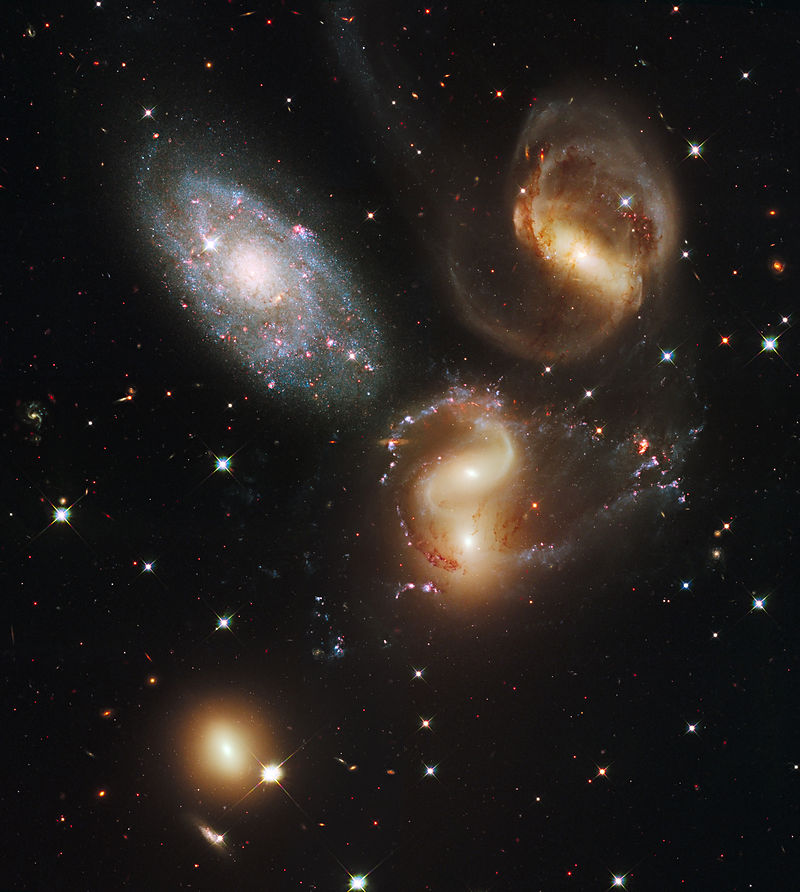NGC 7317
Alternate: Caldwell 30, Hickson Compact Group 92, Arp 319
Pegasus
RA 22h 35 m 51.9 s
Dec +33º56′ 42”
Magnitude 14.6
NGC 7318a
Alternate:Hickson Compact Group 92, Arp 319
Pegasus
RA 22h 35 m 56.7 s
Dec +33º57′ 56”
Magnitude 14.3
NGC 7318b
Alternate:Hickson Compact Group 92, Arp 319
Pegasus
RA 22h 35 m 58.4 s
Dec +33º57′ 57”
Magnitude 13.9
NGC 7319
Alternate:Hickson Compact Group 92, Arp 319
Pegasus
RA 22h 36 m 03.5 s
Dec +33º58′ 33”
Magnitude 14.1
NGC 7320c
Alternate:Hickson Compact Group 92, Arp 319
Pegasus
RA 22h 36 m 20.4 s
Dec +33º59′ 06”
Magnitude 16.7
The Hickson Compact Group 92 was discovered by Edouard M. Stephan in 1877, during his tenure as the director of the Marseille Observatory in France.
The famous Stephan’s Quintet is the first compact galaxy group ever discovered. Stephan’s Quintet is a group of five galaxies, of which four members are interacting and one, NGC 7320c is a foreground galaxy.
Edouard M. Stephan was a French astronomer, and was the director of the Marseille Observatory from
1864 to 1907. Besides his discovery of Stephan’s Quintet, he was the discoverer of asteroid 89 Julia and galaxy NGC 6027.
NGC 7320c is about seven times closer to Earth than the rest of the group. Three of the galaxies have distorted shapes, elongated spiral arms, and long, gaseous tidal tails containing myriad star clusters, clearly the evidence of their close encounters. These interactions have sparked a frenzy of star birth in the central pair of galaxies.
NGC 7319, is an SB peculiar barred spiral with distinct spiral arms that follow nearly 180 degrees back to the bar.
NGC 7318A, an E2 peculiar galaxy, and NGC 7318B, an SB peculiar galaxy, are two galaxies appearing as one galaxy with two cores in both amateur and Hubble images. Encircling the galaxies are young, bright blue star clusters and pinkish clouds of glowing hydrogen where infant stars are being born. These stars are less than 10 million years old and have not yet blown away from their birth cloud.
NGC 7317 is an E4 elliptical galaxy that is less affected by the interactions.
Sharply contrasting with these galaxies is the dwarf SAB galaxy NGC 7320c. NGC 7320c is 40 million light-years from Earth. The other members of the quintet reside 290 million light-years away.
I observed Stephan’s Quintet in all its glory through both an 18” and a 24” Dobsonian telescope at the 2014 Winter Star Party in the Florida Keys. Stephan’s Quintet could be detected from my old 11” SCT from my backyard in the heart of the Cross Junction/Gore area Virginia, with four of its members popping into view and one member playing hide-and seek with averted vision. I have not attempted to view Stephon’s Quintet with my new 9.25” SCT. (For those readers who are wondering, I replaced my 11” with the 9.25” because of size and weight issues. I’m 68 years old and moving an 11” SCT was a strain.) Since the Hickson Compact Group 92 is so tightly concentrated, a medium to medium-high magnification with 60ºAFOV eyepiece is all that is necessary to view the galaxy group.
To all astro-imagers, a wide field image of The Deer Lick Group and Stephan’s Quintet can form a “mega-Cosmic Duet” photographically.
